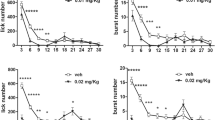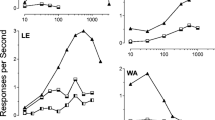Abstract
In order to assess the effects of the atypical neuroleptic clozapine on orolingual competence in rats, tongue function was measured by quantitating the rhythm of tongue movements after acute (1.0, 3.0, 6.0 mg/kg) or subchronic intraperitoneal treatment (1.5, 3.0, 4.5 mg/kg, each dose for at least 7 days) with the drug. Thirsty rats were trained to lick water from a force-sensing disk by thrusting the tongue through a 12-mm-diameter hole to strike the horizontal disk located 5 mm below the hole. Number of licks in 2 min and rhythm of tongue movements (as determined by Fourier analysis of the force-time signal) were each dose dependently reduced in the acute dose-effect phase of the study. In the subchronic study number of licks exhibited tolerance, but the slowing of lick rhythm did not show tolerance. An acute dose range of the serotonin antagonist ritanserin (0.5, 1.0, 2.0, 4.0 mg/kg) was also studied in the same rats. Ritanserin had no effect on any of the measures of orolingual function. The clozapine result was replicated in a second study using younger, drug naive rats. The results for clozapine were contrasted with previous reports indicating that haloperidol has little effect on lick rhythm. Additional discussion evaluated the possible contribution of neurotransmitter receptors on motor neurons of the hypoglossal nucleus to the observed rhythm slowing induced by clozapine.
Similar content being viewed by others
References
Aldes LD, Chronister RB, Shelton C, Haycock JW, Marco LA, Wong DL (1988) Catecholamine innervation of the rat hypoglossal nucleus. Brain Res Bull 21:305–312
Baldessarini RJ, Frankenburg FF (1991) Clozapine: a novel antipsychotic agent. N Engl J Med 324:746–754
Bruhwyler J, Chleide E, Houbeau G, Waegeneer N, Mercier M (1993) Differentiation of haloperidol and clozapine using a complex operant schedule in the dog. Pharmacol Biochem Behav 44:181–189
Bymaster FP, Heath I, Hendrix JC, Shannon HE (1993) Comparative behavioral and neurochemical activities of cholinergic antagonists in rats. J Pharmacol Exp Ther 267:16–24
Costall B, Naylor RJ (1975) Detection of the neuroleptic properties of clozapine, sulpiride, and thioridazine. Psychopharmacologia 43:69–74
Faustman WO, Fowler SC, Walker CH (1981) Time course of chronic haloperidol and clozapine upon operant rate and duration. Eur J Pharmacol 70:65–70
Fowler SC, Das S (1994) Haloperidol-induced decrements in force and duration of rats' tongue movements during licking are attenuated by concomitant anticholinergic treatment. Pharmacol Biochem Behav 49:813–817
Fowler SC, Mortell C (1992) Low doses of haloperidol interfere with rat tongue extensions during licking: a quantitative analysis. Behav Neurosci 106:386–395
Fowler SC, Davison KH, Stanford JA (1994) Unlike haloperidol, clozapine slows and dampens rats' forelimb force oscillations and decreases force output in a press-while-licking behavioral task. Psychopharmacology 116:19–25
Idanpaan-Heikkila J, Alhava E, Olkinuira M, Palva IP (1977) Agranulocytosis during treatment with clozapine. Eur J Clin Pharmacol 11:193–198
Jacobs BL, Fornal CA (1993) 5-HT and motor control: a hypothesis. Trends Neurosci 16:346–352
Kaempf GL, Porter JH (1987) Differential effects of pimozide and clozapine on schedule-controlled and scheduled-induced behaviors after acute and chronic administration. J Pharmacol Exp Ther 243:437–445
Kubin L, Tojima H, Davies RO, Pack AI (1992) Serotonergic excitatory drive to hypoglossal motoneurons in the decerebrate cat. Neurosci Lett 139:243–248
Leysen JE, Gommeren W, Van Gompel P, Wynants J, Janssen PFM, Laduron PM (1985) Receptor-binding properties in vitro and in vivo of ritanserin: a very potent and long acting serotonin-S2 antagonist. Mol Pharmacol 27:600–611
Leysen JE, Janssen PMF, Schotte A, Luyten WHML, Megens, AAHP (1993) Interactions of antipsychotic drugs with neurotransmitter receptor sites in vitro and in vivo in relation to pharmacological and clinical effects: role of 5-HT2 receptors. Psychopharmacology 112[suppl]:s40-s54
Ljungberg T, Ungerstedt U (1979) Evidence that the different properties of haloperidol and clozapine are not explained by differences in anticholinergic potency. Psychopharmacology 60:303–307
Meltzer HY, Matsubara S, Lee, J-C (1989) Classification of typical and atypical antipsychotic drugs on the basis of dopamine D-1, D-2, and serotonin2 pKi values. J Pharmacol Exp Ther 251:238–246
Meltzer HY (1992a) Clozapine: Pattern of efficacy in treatment resistant schizophrenia. In: Meltzer HY (ed) Novel antipsychotic drugs. Raven Press, New York, pp 33–46
Meltzer HY (1992b) The mechanism of action of clozapine in relation to its clinical advantages. In: Meltzer HY (ed) Novel antipsychotic drugs. Raven Press, New York, pp 1–13
Moore NA, Calligaro DO, Wong DT, Bymaster F, Tye NC (1993) The pharmacology of olanzapine and other new antipsychotic agents. Curr Opin Invest Drugs 2:281–293
Rebec GV, Peirson E, McPherson F, Brugge K (1982) Differential sensitivity to amphetamine following long-term treatment with clozapine or haloperidol. Psychopharmacology 77:360–366
Sanger DJ (1985) The effects of clozapine on shuttle-box avoidance responding in rats: comparisons with haloperidol and chlordiazepoxide. Pharmacol Biochem Behav 23:231–236
Sanger DJ, Perrault G (1995) Effects of typical and atypical antipsychotic drugs on response decrement patterns in rats. J Pharmacol Exp Ther 272:708–713
Schmauss M, Wolff R, Erfurth A, Ruther E (1989) Tolerability of long term clozapine treatment. Psychopharmacology 99[Suppl]:S105-S108
Stille G, Lauener H, Eichenberger E (1971) The pharmacology of 8-chloro-11-(4-methyl-1-piperazinyl)-5H-dibenzo(b,e) (1,4)diazepine(clozapine). Farmaco 26:603–625
Tarsy D (1989) Neuroleptic-induced movement disorders. In: Quinn NP, Jenner PG (eds) Disorders of movement: clinical, pharmacological and physiological aspects. Academic Press, New York, pp 361–393
Wiley JL, Compton AD, Porter JH (1993) Effects of four antipsychotics on punished responding in rats. Pharmacol Biochem Behav 45:263–267
Author information
Authors and Affiliations
Rights and permissions
About this article
Cite this article
Das, S., Fowler, S.C. Acute and subchronic effects of clozapine on licking in rats: tolerance to disruptive effects on number of licks, but no tolerance to rhythm slowing. Psychopharmacology 120, 249–255 (1995). https://doi.org/10.1007/BF02311171
Received:
Revised:
Issue Date:
DOI: https://doi.org/10.1007/BF02311171




